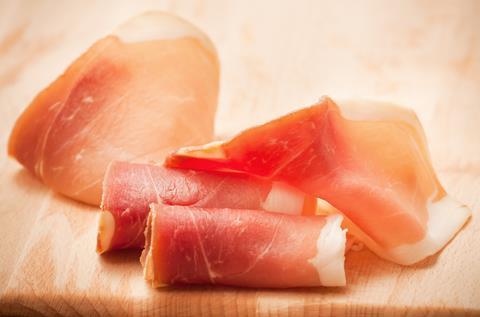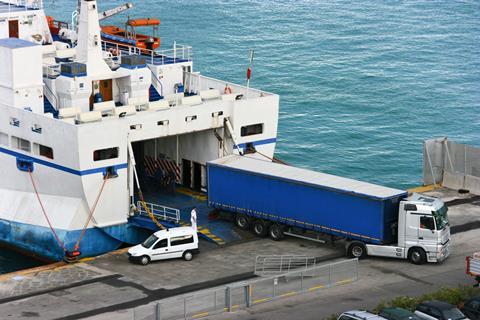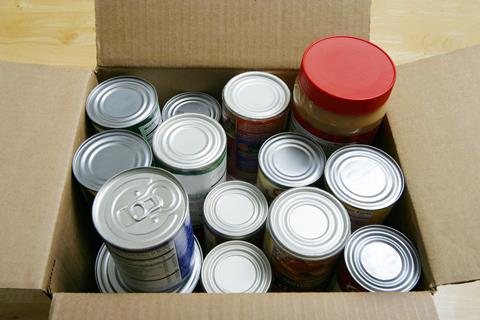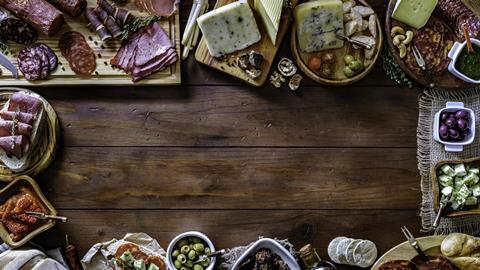New Brexit checks are about to make it harder for SMEs to import meat and dairy goods from Europe, raising fears for the future of independent delis and the wholesalers who supply them
The “ultimate and eventual outcome of Brexit”, foreign secretary James Cleverly last month told the European parliament, is “close and friendly co-operation between the UK and EU, because that is the sensible and pragmatic outcome”.
“Sensible and pragmatic” are words few in the food and drink industry would use to describe new trading requirements for EU imports set to kick in from October.
The much-delayed new Border Target Operating Model (TOM) aims to end Brexit uncertainty, according to the government, by setting out a ‘simplified’ plan for goods entering the UK. But for those looking to bring in small shipments of artisanal goods such as French camembert, Spanish manchego, or Italian parma ham, it’s looking like another costly and time-consuming bureaucratic minefield. And one senior customs source told The Grocer at an industry event earlier this month, “this could be the death of the deli”.
So how will the new Border Target Operating Model work? As with most things Brexit, it remains unclear how things will pan out at the border. What we know is that, as things stand, 31 October will bring the rollout of controls effectively classing the EU as ‘overseas’ territory and will treat goods coming in accordingly.
Timings
The TOM will take effect in phases to allow traders to prepare. The first phase will require health certification for medium and high-risk food products, such as meat and some dairy. Physical checks at designated border control posts (BCPs) will kick in from January next year.
The government says the TOM will streamline trading processes and save businesses up to £400m a year. But for small-scale businesses importing smaller volumes of artisan goods from the continent, it’s looking like more bad news. Already the 2021 introduction of new customs requirements for EU goods has caused costs to shoot up for small consignments, severely restricting trade, explains Kamil Shah, co-founder of The Greek Kitchen and My Olive Branch.
“Before, you’d have importers in the UK who would consolidate, for example, a pallet in Athens made up of products from suppliers from all over Greece and ship it as if sending a parcel from London to Manchester,” says Shah, who imports artisan products from the southern Mediterranean. This is a method known as groupage – combining small shipments of goods that have the same or near origin and destination.
When customs checks came in, clearance was needed for each of the suppliers’ products when leaving Greece and entering the UK. Some saw costs rise by up to £3,000 a shipment in customs paperwork alone, Shah says. For many, that was the final straw.
“All these small artisan producers stopped what they were doing because it wasn’t financially viable and the people left in the market were the bigger companies.”
Border Target Operating Model timetable
31 October 2023
(date proposed but not confirmed)
Introduction of health certification on imports of medium-risk animal products, plants, plant products and high-risk food and feed of non-animal origin from EU.
End of 2023
(date proposed but not confirmed)
Introduction of permanent waivers from requirement to submit safety and security declarations on certain categories of low-risk movements, including of fish caught in UK territorial seas and landed outside the UK, outbound transit and certain outbound freeport goods.
31 January 2024
(date proposed but not confirmed)
Introduction of documentary and risk-based identity and physical checks on medium-risk animal products, plants, plant products and high-risk food and feed of non-animal origin from EU. At this point, imports of sanitary and phytosanitary goods from non-EU countries will align with the TOM regime. Existing inspections of high-risk plants/plant products from the EU, Switzerland and Liechtenstein will move from destination to border control posts/control points.
31 October 2024
(date proposed but not confirmed)
Safety and security declarations for EU imports come into force.
Shah expects more of the same when the full border controls arrive, with traders facing further costs, including export health certificates, veterinarian fees and, subject to a current government consultation, a potential border inspection fee.
It’s a reasonable prediction, as this happened when EU countries applied full customs requirements and checks on British exports at the start of 2021. Exports to the EU plunged by 40% (or £5.6bn) in the first month of Brexit, according to Office for National Statistics data, with exports of food and live animals collapsing 63.3%.
After that initial slump, export volumes to the EU have now recovered to pre-pandemic levels, according to the latest annual FDF trade figures. However, some SMEs were so badly affected by that change in trade rules that, if they have not stopped altogether, they have certainly struggled to recover.
In the last quarter of 2022, almost one in 10 (9%) small businesses had temporarily halted trading with the EU, according to the Federation of Small Businesses’ Customs Clearance 2023 report, while 4%-5% had permanently stopped.

With groupage shipments accounting for around 65% of all goods arriving in the UK, according to Cabinet Office data, there are real concerns on the impact of the new proposals for a truck carrying multiple products from an array of suppliers with different risk categorisations – as is often the case with independent wholesalers or speciality shops selling to delicatessens only.
As it stands, medium and high-risk goods will be eligible for physical checks at designated BCPs, which will mean an entire mixed load will have to be stopped and checked if even one product falls under that categorisation. And it won’t come cheap: under TOM proposals, businesses will be charged up to £43 per consignment to help fund the new border facilities.
The government claims the Border Target Operating Model will streamline the process for bringing food into the UK and save the industry £400m a year
Unfair pricing
Nigel Jenney, CEO of the Fresh Produce Consortium, argues the fee is “neither reasonable nor fair, especially to SMEs” trading small quantities of diverse goods.
He points out that a large food supplier who can fill a lorry with many pallets of the same product – for instance headed to a big supermarket – would pay a single fee for the entire load. But an independent wholesaler bringing in an array of products from mixed suppliers could be looking at hundreds or even thousands of pounds in fees.

“Whether it’s your Polish grocer or your Italian deli moving a single wheel of cheese or a single salami, they’ll find it more challenging,” says FDF international trade head Dominic Goudie. They might go from “shifting a pallet as and when they needed to go to a customer, to having a dedicated lorry once every week or two that may be half-empty”.
Cold Chain Federation CEO Shane Brennan argues that stockpiling will create an opportunity here “for more specialist import businesses to buy goods, import, hold and sell to order from a UK base”.
He also sees “doing a vet deal that would bring food safety rules back in to alignment between the UK and EU and therefore remove the need for consignment-by-consignment controls” as a sensible solution to the burdensome red tape groupage faces – though he thinks it unlikely for now as it goes against the government’s desire to call its own regulatory shots post Brexit.
“Whether it’s your Polish grocer or your Italian deli, moving a single wheel of cheese or a single salami, they’ll find it more challenging”
Dominic Goudie, FDF international trade head
The TOM’s ultimate goal is a Single Trade Window digital model that gives traders a single gateway for all necessary information so as to simplify the process, with its launch expected in October 2024.
Until then, groupage-reliant businesses have no option but to jump through all the bureaucratic hoops. The FDF’s Goudie believes some will “inevitably stop moving goods – at least for a period of time” as they adjust to the new requirements.
Supermarkets are more likely to be acquainted with this level of bureaucracy as they already import lots of products from outside the EU and their higher-volume shipments are not groupage dependent, Brennan says. But it’s “still a major headache” as they face “millions in additional costs”, he adds.
The checks cause delays for all the businesses involved in moving the goods, because “time is money”, says Walter Anzer, director general at the British Food Importers & Distributors Association. “This is something that is not said very often but it is the truth – it’s not easy to find hauliers in Europe to come here because they’re afraid of hold-ups. And when a lorry is stuck and not on the road, it doesn’t make money.”

Risk categories
The extent of the impact on businesses will also depend on which products end up falling in the medium and high-risk categories.
As per Defra’s latest update to risk categorisation, cheese products containing non-raw milk, also known as pasteurised cheeses – such as Cypriot halloumi and Dutch gouda – will be considered low risk. But most of Europe’s artisan cheeses, which contain raw milk, including camembert and gruyere, will be considered medium risk and subject to tighter controls.
There have been rumours the government may widen the scope of low-risk goods, not least as many countries in Europe have shortages of veterinarians that can issue the certificates required for higher-risk products. Putting certain dairy, meat and fish goods into a lower category would mean less checks at the borders and therefore a more efficient trade flow.
Defra has confirmed that goods may move between risk categories from time to time based on their risk profile, and that it aims to give traders a minimum of three months notice of any change to categorisation.
But the uncertainty of it all still makes it hard to predict the effects, leaving businesses such as Devon-based Meridian Sea in a quandary. The wholesaler sells seafood products from France and the Mediterranean, and owner Nigel Vogwill expects costs to increase by as much as 5%. He is waiting to see if his clients will be able to help absorb such an increase, but warns “the range is under review”, so “if something is put up to an extent that is unbuyable… I would think that product would be priced out of the market.
“We have been absorbing various costs as things have progressed since three years ago. We don’t really know what happens next, but we’re doing our best.”
Some are taking positive action in anticipation of the changes. In Belgium, food producers exporting to the UK have been gearing up for months, says Tine Vandervelden, international business director for Fevia, Belgium’s equivalent to the FDF.
“Because of Belgium’s closeness to the UK and the importance of the market, we prepared our companies together with government very well for the first phase of Brexit,” she says, referring to the introduction of customs declarations in 2021. This level of preparation, which included regular workshops and seminars with members, was crucial for SMEs that had never exported outside the EU.
“It was a bit of a learning curve for the smaller companies, but our exports actually grew in the first year of those controls.”
Fevia has been closely following the new proposals so it can update members on any changes promptly. It is also working with the government to understand how many certificates each business will require so they have the necessary paperwork when the checks begin.
“It’s not easy to find hauliers in Europe to come here because they’re afraid of holdups”
Walter Anzer, director general at the British Food Importers & Distributors Association
But the deadline is still a major concern, as many businesses will have little time to prepare as the government has still not delivered the final guidance.
“Our main advice to our companies is that they talk with all their partners in the process and check the contracts they already have in place with their buyers,” Vandervelden says. “The question is: we will have a higher cost, so can we translate this in our prices to our clients in the UK, because someone will have to pay?”
And that someone may be the consumer, with Brexit pushing up household bills by an average of £250 per year, a study by the London School of Economics found. Indeed, between January 2022 and March 2023 alone, the price of food products most exposed to Brexit red tape – such as cheese and meat – increased by 3.5 percentage points more than those that were not.

Shah from My Olive Branch argues there will still be lots of businesses importing speciality goods. “But the prices are just going to become crazy and the choice that will be available won’t be as good and more oriented towards the mass market,” he says.
Supermarkets may move first
Vandervelden thinks supermarkets will be first to ditch artisan food suppliers as shoppers grow increasingly price-sensitive. In speciality shops, she points out, “the clientele is used to paying a bit more”.
The BRC’s director of food & sustainability Andrew Opie confirms that supermarkets have been routinely reviewing their ranges against the current backdrop of stubbornly high food inflation, and will not hesitate to adjust their offering if certain continental products become too expensive.
So, while TOM may not bring about the death of the deli, it will likely take a toll on ranging and price across all of food and drink. And it won’t just be businesses that suffer. As Vandervelden puts it, “the biggest victim in all this” will be the average British shopper.




















No comments yet